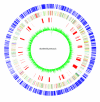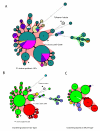Changes in the genomic content of circulating Bordetella pertussis strains isolated from the Netherlands, Sweden, Japan and Australia: adaptive evolution or drift?
- PMID: 20102608
- PMCID: PMC2834637
- DOI: 10.1186/1471-2164-11-64
Changes in the genomic content of circulating Bordetella pertussis strains isolated from the Netherlands, Sweden, Japan and Australia: adaptive evolution or drift?
Abstract
Background: Bordetella pertussis is the causative agent of human whooping cough (pertussis) and is particularly severe in infants. Despite worldwide vaccinations, whooping cough remains a public health problem. A significant increase in the incidence of whooping cough has been observed in many countries since the 1990s. Several reasons for the re-emergence of this highly contagious disease have been suggested. A particularly intriguing possibility is based on evidence indicating that pathogen adaptation may play a role in this process. In an attempt to gain insight into the genomic make-up of B. pertussis over the last 60 years, we used an oligonucleotide DNA microarray to compare the genomic contents of a collection of 171 strains of B. pertussis isolates from different countries.
Results: The CGH microarray analysis estimated the core genome of B. pertussis, to consist of 3,281 CDSs that are conserved among all B. pertussis strains, and represent 84.8% of all CDSs found in the 171 B. pertussis strains. A total of 64 regions of difference consisting of one or more contiguous CDSs were identified among the variable genes. CGH data also revealed that the genome size of B. pertussis strains is decreasing progressively over the past 60 years. Phylogenetic analysis of microarray data generated a minimum spanning tree that depicted the phylogenetic structure of the strains. B. pertussis strains with the same gene content were found in several different countries. However, geographic specificity of the B. pertussis strains was not observed. The gene content was determined to highly correlate with the ptxP-type of the strains.
Conclusions: An overview of genomic contents of a large collection of isolates from different countries allowed us to derive a core genome and a phylogenetic structure of B. pertussis. Our results show that B. pertussis is a dynamic organism that continues to evolve.
Figures







Similar articles
-
Bordetella pertussis evolution in the (functional) genomics era.Pathog Dis. 2015 Nov;73(8):ftv064. doi: 10.1093/femspd/ftv064. Epub 2015 Aug 21. Pathog Dis. 2015. PMID: 26297914 Free PMC article. Review.
-
Comparative genomic profiling of Dutch clinical Bordetella pertussis isolates using DNA microarrays: identification of genes absent from epidemic strains.BMC Genomics. 2008 Jun 30;9:311. doi: 10.1186/1471-2164-9-311. BMC Genomics. 2008. PMID: 18590534 Free PMC article.
-
Global population structure and evolution of Bordetella pertussis and their relationship with vaccination.mBio. 2014 Apr 22;5(2):e01074. doi: 10.1128/mBio.01074-14. mBio. 2014. PMID: 24757216 Free PMC article.
-
Multiple-locus variable-number tandem repeat analysis of Dutch Bordetella pertussis strains reveals rapid genetic changes with clonal expansion during the late 1990s.J Bacteriol. 2004 Aug;186(16):5496-505. doi: 10.1128/JB.186.16.5496-5505.2004. J Bacteriol. 2004. PMID: 15292152 Free PMC article.
-
Epidemiology of whooping cough & typing of Bordetella pertussis.Future Microbiol. 2013 Nov;8(11):1391-403. doi: 10.2217/fmb.13.111. Future Microbiol. 2013. PMID: 24199799 Review.
Cited by
-
Whole-genome sequencing reveals the effect of vaccination on the evolution of Bordetella pertussis.Sci Rep. 2015 Aug 18;5:12888. doi: 10.1038/srep12888. Sci Rep. 2015. PMID: 26283022 Free PMC article.
-
Small mutations in Bordetella pertussis are associated with selective sweeps.PLoS One. 2012;7(9):e46407. doi: 10.1371/journal.pone.0046407. Epub 2012 Sep 28. PLoS One. 2012. PMID: 23029513 Free PMC article.
-
Bordetella pertussis evolution in the (functional) genomics era.Pathog Dis. 2015 Nov;73(8):ftv064. doi: 10.1093/femspd/ftv064. Epub 2015 Aug 21. Pathog Dis. 2015. PMID: 26297914 Free PMC article. Review.
-
The evolutionary consequences of blood-stage vaccination on the rodent malaria Plasmodium chabaudi.PLoS Biol. 2012;10(7):e1001368. doi: 10.1371/journal.pbio.1001368. Epub 2012 Jul 31. PLoS Biol. 2012. PMID: 22870063 Free PMC article.
-
Genome-wide gene expression analysis of Bordetella pertussis isolates associated with a resurgence in pertussis: elucidation of factors involved in the increased fitness of epidemic strains.PLoS One. 2013 Jun 11;8(6):e66150. doi: 10.1371/journal.pone.0066150. Print 2013. PLoS One. 2013. PMID: 23776625 Free PMC article.
References
-
- Heininger U, Stehr K, Schmitt-Grohe S, Lorenz C, Rost R, Christenson PD. et al.Clinical characteristics of illness caused by Bordetella parapertussis compared with illness caused by Bordetella pertussis. Pediatr Infect Dis J. 1994;13:306–309. - PubMed
Publication types
MeSH terms
Substances
LinkOut - more resources
Full Text Sources
Miscellaneous

